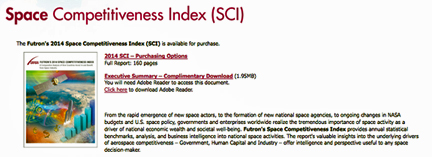
[SatNews] Futron recently released their 2014 Space Competitiveness Index: A Comparative Analysis of How Countries Invest In and Benefit from Space Industry.

This report marks the firm's seventh annual independent study of global space competitiveness. Building on their pioneering analysis framework and global knowledge base, Futron's 2014 SCI examines multi-year trends across three fundamental dimensions of space competitiveness-government, human capital, and industry-for 15 leading space-participant nations: Argentina, Australia, Brazil, Canada, China, Europe, India, Iran, Israel, Japan, Russia, South Africa, South Korea, Ukraine, and the United States.
The report offers detailed country-by-country profiles of each nation's space activities and trends, future plans, relative competitive positioning, and strengths, weaknesses, opportunities, and threats. Beyond the report, Futron has also announced that the extensive data set used to produce the 2014 SCI, featuring more than 60 spreadsheets of supporting metric information, is also available.
Among their 2014 findings:
- The United States remains the leader in space competitiveness, but is the only nation to decline for seven straight years. As other countries enhance their space capabilities while the U.S. navigates uncertain transitions, its currently unique convening power in setting the global space agenda is not guaranteed.
- Globalization of space activity is accelerating, with emerging nations quickly establishing themselves as competitors to traditional leaders. Two emerging nations moved up by one rank in our 2014 results, displacing countries that had previously occupied those positions.
- At least 15 other nations besides those analyzed in the 2014 SCI can be classified as nascent space actors. These countries, spanning Africa, Latin America, the Middle East, and Southeast Asia, could be viewed as "the next 15," and may soon contend with the current 15 nations analyzed in the report.
- International collaboration is increasingly taking shape as a concerted space competitiveness strategy, especially among smaller actors.
- Four distinct space competitiveness tiers have emerged. The first tier of traditional space leaders is becoming more internally competitive, but has also shown some stabilization. The second tier of space powers is intensely competitive: each country could plausibly surpass its near-peers within a short period of time. The third and fourth tiers are highly dynamic and diversified: nations with disparate activities attained similar scores, but for different reasons. And throughout our analysis, small gaps in score results could make large differences in competitive positioning.
For more highlights, download a complimentary copy of the 2014 SCI Executive Summary at http://www.futron.com/.

